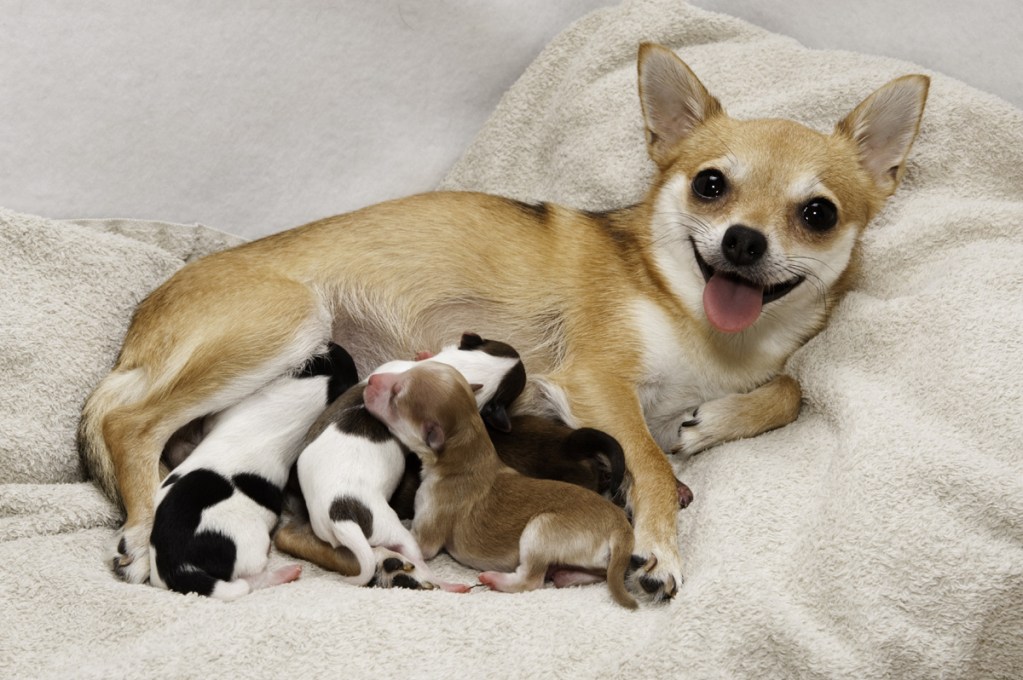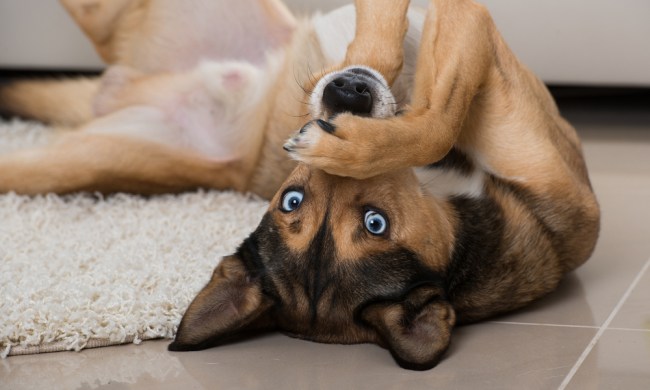Whether or not you’re planning on breeding your dog, there’s a lot of value in learning about dog pregnancy stages and how to care for a dog who’s expecting. Especially if you’re the kind of person who would rescue a dog in need, you never know when you (or someone around you) might benefit from this knowledge. As adorable and exciting as puppies are, do you know how to handle what comes first?
If you look at dog pregnancy week by week, it’s much simpler to understand. You’ll be able to break down the tasks and to-do’s so you’ll always be able to give your expectant pup the love and care she deserves. Nothing is better than a healthy and happy mama and babies! Here’s what you need to know:

How long is a dog pregnant?
Although there is an answer, the reality of every pregnancy will vary. The American Kennel Club reports that the average gestation period for a dog is 63 days from conception to birth. This can vary because it can be nearly impossible to tell exactly when conception occurs in canines. Once mating occurs, sperm can stay alive inside the female for up to a few days. Puppies are fully developed around day 58, so labor can begin as early as then.

What to do following mating
Whether or not your dog’s mating was planned, it’s important to be mindful of her health and activities after she’s been bred. Not much will change until several weeks into the pregnancy–after a veterinarian has confirmed it–but a dog’s fertile period isn’t always crystal clear. With intentional breeding, dogs often mate twice within the span of 1-2 days to ensure mating happens during the right time. But when accidents happen, or dogs are left unsupervised, it’s possible for two different males to mate with one female during her fertile period. Yes–it’s possible for one litter of puppies to have two fathers!
To avoid this, keep any mated female away from intact males for the rest of her fertile period. It may even help to have her rest after mating, too! She doesn’t need to limit her activities, change her high-quality dog food, or take any medications after breeding, though making an appointment with her vet to confirm the pregnancy will be a good idea.
About three to four weeks post-mating, a veterinarian can use a variety of tests to confirm or deny signs of pregnancy. This could range from abdominal palpitation to an ultrasound or blood test, but you will have to be patient!

Dog pregnancy stages
Since gestation for pups lasts only nine weeks, it’ll move a lot faster than a human pregnancy. For more information, Baldivis Vet Hospital provides week-by-week dog pregnancy guides to keep you informed.
Month one
During the first week after mating, the embryos will move toward the uterine horns — though they don’t attach to the wall just yet (via BVH). This happens during week three. Until then, embryos stay safe in the uterus, so your sweet dog can maintain her normal routine — unless your vet says otherwise, of course!
During week four, your pup will start showing pregnancy symptoms: fatigue, morning sickness, and increased appetite. You may also notice enlarged nipples and a clear vaginal discharge, though your vet will also use blood tests and hormone levels to confirm your dog’s pregnancy, estimated due date, and–fingers crossed–a clean bill of health (via BVH).
By the end of the first month, each fetus will begin to take shape. The AKC estimates that fetal heartbeats can be detected by day 30 of gestation.
Month two
Around week five, the embryos are now considered fetuses. Organs begin to form, and each fetus will grow significantly in the coming weeks, which is when you can expect to see (and make) many changes (via BVH).
By six and seven weeks, the real development begins. The puppies’ claws and coat form, and the skeleton hardens around day 45. Your vet may be able to tell how many puppies are in the litter around this time (via AKC). It’s also a good idea to have your pregnant dog preemptively treated for worms to keep the puppies safe, though she may be more interested in nesting.
During week eight, begin preparing your dog’s nesting — or whelping — area. Some noticeable changes to look out for in your dog during this second month include:
- Increased appetite until day 45, then decreased appetite
- Growing abdomen, visible movement from puppies
- Weight gain
- Frequent urination
- Behavioral changes
Month three, including birth
About one week before whelping, your dog will start producing milk (via BVH). Don’t use this to guess when labor will be, though it can be a heads-up. You’ll want to keep puppy formula on hand, too, just in case.
Around this time, especially after day 58, the puppies will be noticeably lower in the abdomen as they move into the birth canal. Your dog will continue to be restless and will experience a small drop in body temperature about 12–24 hours before labor begins.
In the first stage of labor, look out for increased nesting, clear vaginal discharge, and other signs of stress in your pregnant dog. She will naturally move to her ideal nesting area–which may not be the one you prepared–so you might have to rearrange a few things to keep her comfortable.
Generally, a dog will handle labor and birth like a champ completely on her own, as the process isn’t as dramatic as a human birth. Still, you should be nearby to make sure everything goes smoothly. You may have to gently open the fetal sac of each pup if the puppies are arriving right after one another. In most cases, the new mom will do this on her own.
Each delivery should last one to two hours, though it varies. This is when it’s helpful to know how many puppies to expect so you can know when delivery is done or if there are any complications. Don’t forget to have your vet’s number on hand, just in case!

How to make your dog’s pregnancy easier
The best thing you can do for your dog in the later stages of pregnancy is to help her create the most comfortable nesting space possible. It should be someplace quiet and warm, with plenty of blankets, sheets, or even newspaper that can be changed or cleaned frequently. Remember, the new mom will find the best nesting space for her, so be prepared to be flexible.
Your vet will be able to provide the most accurate details on caring for your dog and her pups after birth. They’ll also be able to guide you throughout each stage to keep your dog in the best health possible — diet and hygiene are so important when it comes to canine pregnancy!
With the proper care and TLC, your dog’s pregnancy will be a breeze. Before you know it, your home will be filled with little barks, tiny paws, and so many smiles. Newborn puppies are the sweetest!




